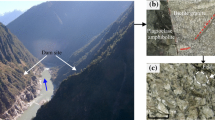Abstract
For any specific rock unit in a discontinuous rock mass, the determination of structural domain boundaries is important because geologic and hydrologic properties vary from one domain to another. A domain can be considered as a structural population characterized by a distinct pattern of structure orientations (i.e., fracture, bedding, or foliation orientations).Boundaries are usually determined by comparing samples of structural data, each of which consists of a Schmidt plot that commonly displays at least 150 poles to fractures. When fracture orientations appear dispersed and random on the plots, visual comparisons are not sufficient to determine whether the samples were obtained from the same structural domain. An appropriate x 2 test has been adapted to this situation and is capable of evaluating the homogeneity of structural populations. The method uses a contingency table analysis based on the frequencies of fracture poles that occur in corresponding patches on the Schmidt plots being compared.
Similar content being viewed by others
References
Abramowitz, M. and Stegun, I. A. (Eds.), 1965, Handbook of mathematical functions: Dover Publ., New York, 1046 p.
Baker, E. J. and Lee, Y., 1975, Alternative analysis of geographical contingency tables: The Professional Geographer, v. 27, p. 179–188.
Call, R. D., Savely, J. P., and Nicholas, D. E., 1976, Estimation of joint set characteristics from surface mapping data: in Proceedings of the 17th U.S. symposium on rock mechanics, Salt Lake City, Utah, p. 2B2.1–2B2.9.
Chapman, D. G. and Schaufele, R. A., 1970, Elementary probability models and statistical inference: Ginn-Blaisdell, Waltham, Mass., p. 276.
Cochran, W. G., 1954, Some methods for strengthening the commonx 2 tests: Biometrics, v. 10, p. 417–451.
Haldane, J. B. S., 1939, The mean and variance ofx 2, when used as a test of homogeneity, when expectations are small: Biometrika, v. 31, p. 346–355.
Lancaster, H. O., 1969, The chi-squared distribution: John Wiley & Sons, New York, p. 175.
Terzaghi, R. D., 1965, Sources of error in joint surveys: Geotechnique, v. 15, no. 3, p. 287–304.
Author information
Authors and Affiliations
Rights and permissions
About this article
Cite this article
Miller, S.M. A statistical method to evaluate homogeneity of structural populations. Mathematical Geology 15, 317–328 (1983). https://doi.org/10.1007/BF01036073
Received:
Revised:
Issue Date:
DOI: https://doi.org/10.1007/BF01036073




